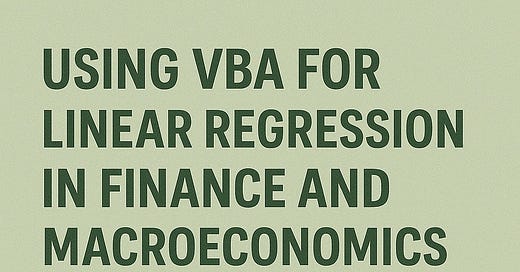Using VBA for Linear Regression in Finance and Macroeconomics: A Complete Excel Automation Guide
Article Outline:
Introduction
The importance of regression analysis in finance and macroeconomics
When and why to automate linear regression in Excel using VBA
Overview of what the reader will achieve by following the guide
Understanding Linear Regression in Economic and Financial Analysis
Brief explanation of linear regression: intercept, slope, residual
Applications in macroeconomics (e.g., investment vs GDP growth, inflation vs money supply)
Applications in finance (e.g., beta estimation, interest rate sensitivity, forecasting returns)
Problem Setup: Modeling GDP Growth Based on Investment Rates
Real-world context: evaluating how investment (as % of GDP) influences GDP growth
Defining variables:
Independent Variable: Investment (% of GDP)
Dependent Variable: GDP Growth Rate (%)
Goal: derive a regression equation and interpret its meaning
Generating and Structuring the Dataset in Excel
Organizing historical economic data in Excel
Recommended structure for time-series analysis (years, investment, growth rate)
Preparing the worksheet for VBA execution
Writing VBA Code to Perform Linear Regression
Step-by-step walkthrough of a VBA macro to:
Compute means, sums, slope, and intercept
Output R² and prediction equation to worksheet
Explanation of the statistical formulae implemented in VBA
How to ensure accuracy and modular design in the macro
Interpreting Regression Results in Context
Understanding what the slope and intercept imply in macroeconomic terms
Explaining R² and its relevance in model fit
Discussing practical meaning: how policymakers or analysts might use the insights
Forecasting GDP Growth Using VBA Model
Extending the VBA code to perform predictions for future investment scenarios
Automating the process of entering new investment rates and returning expected growth
Creating a clean user interface in Excel for ongoing analysis
Visualising the Regression Output with VBA
Adding a scatter plot of actual data
Automatically generating a trendline with regression equation and R² on chart
Enhancing interpretability through well-labeled charts
Conclusion
Recap of how VBA enables repeatable, efficient regression modeling in Excel
Benefits of using automated analysis for economic and financial decision-making
Encouragement to adapt the macro to other variables and scenarios in policy or finance
Keep reading with a 7-day free trial
Subscribe to AI, Analytics & Data Science: Towards Analytics Specialist to keep reading this post and get 7 days of free access to the full post archives.




